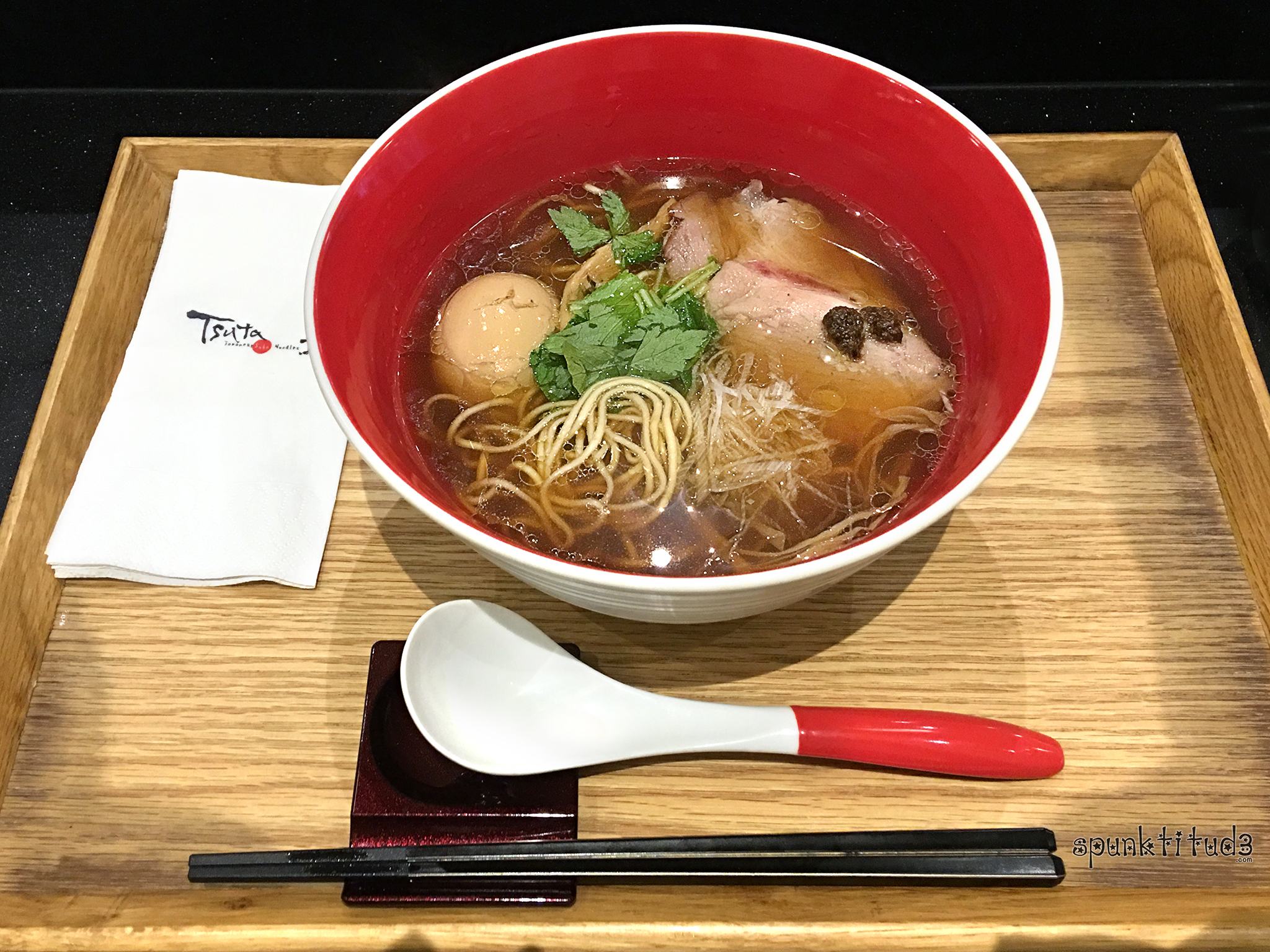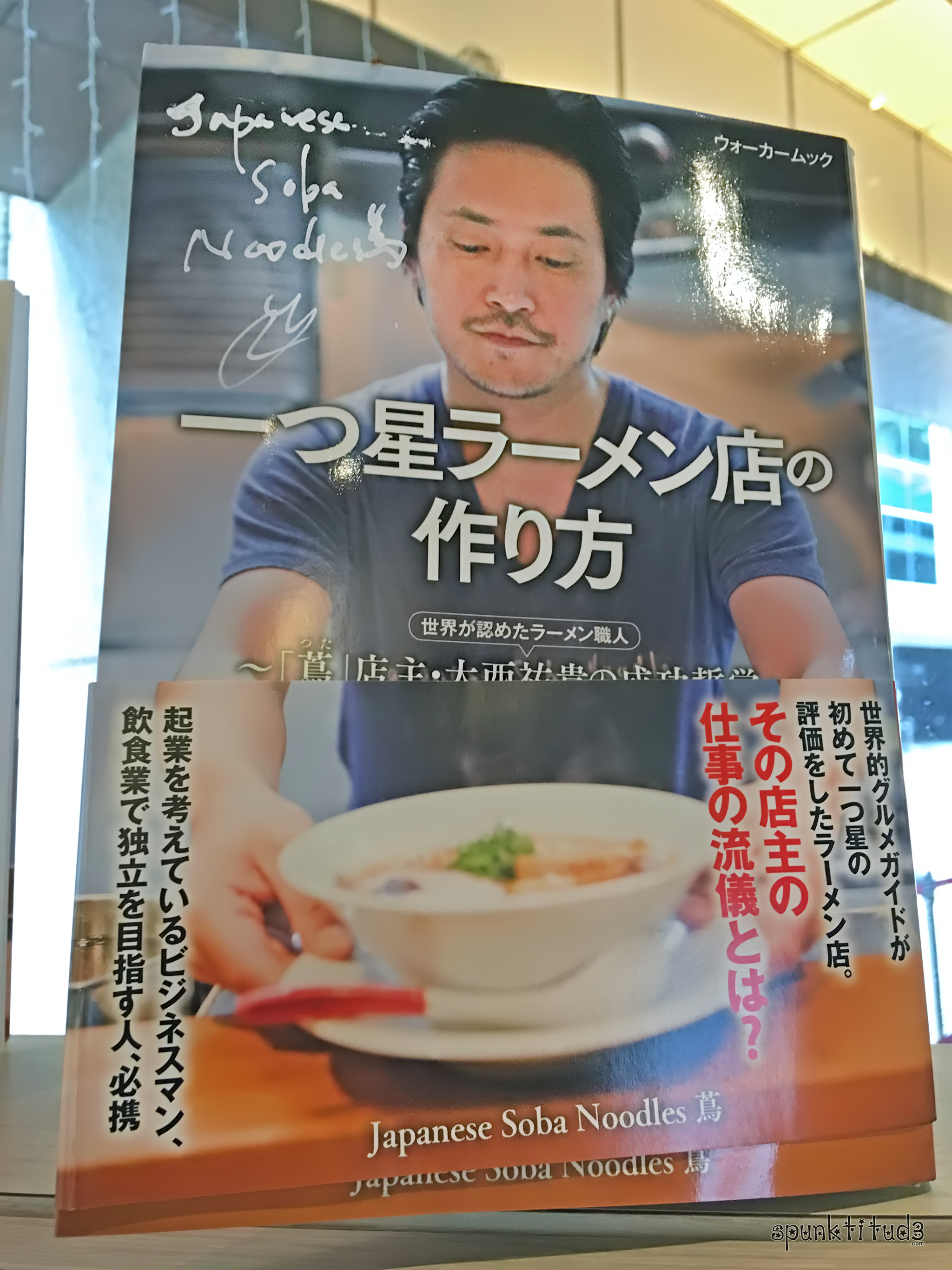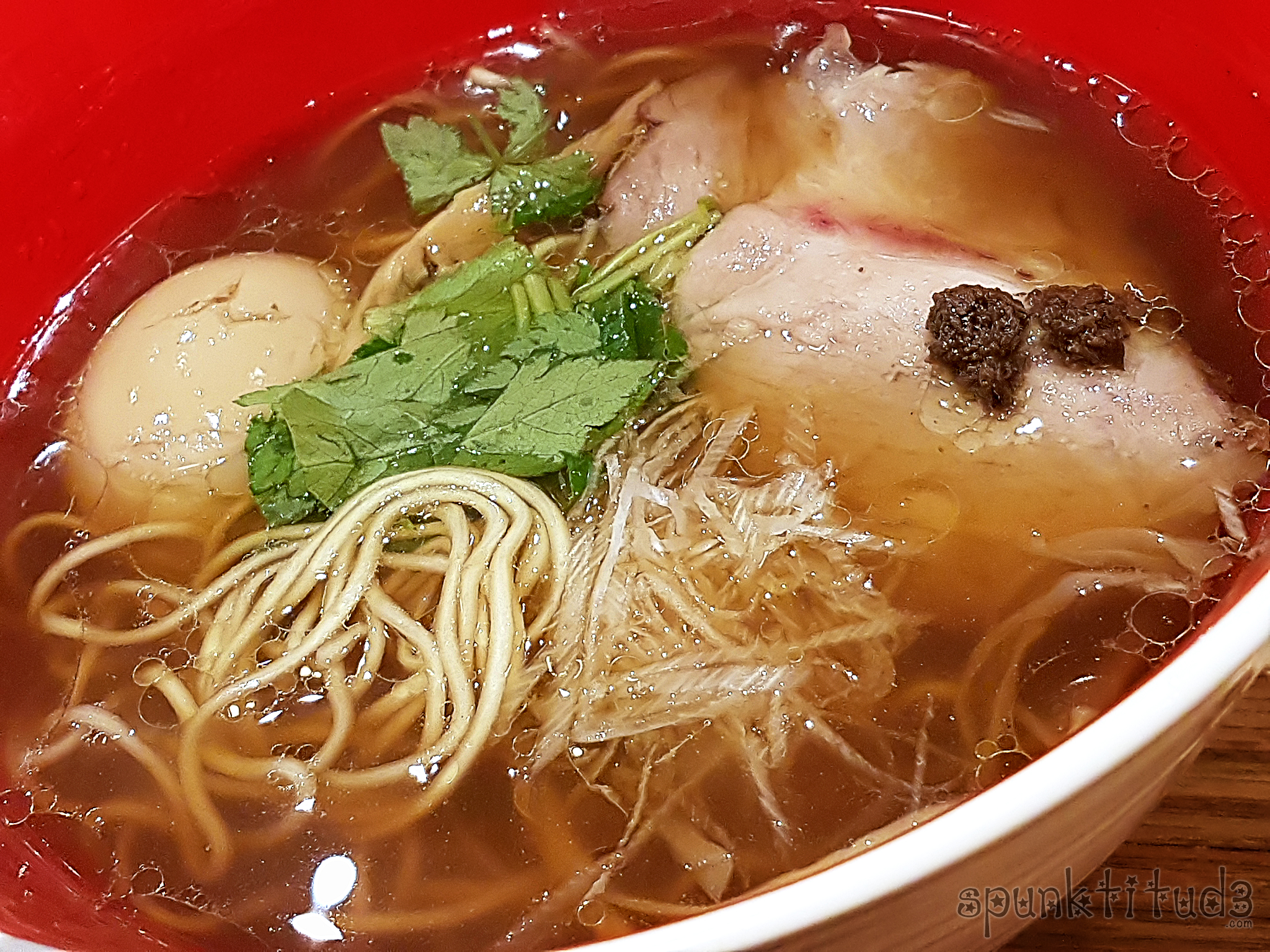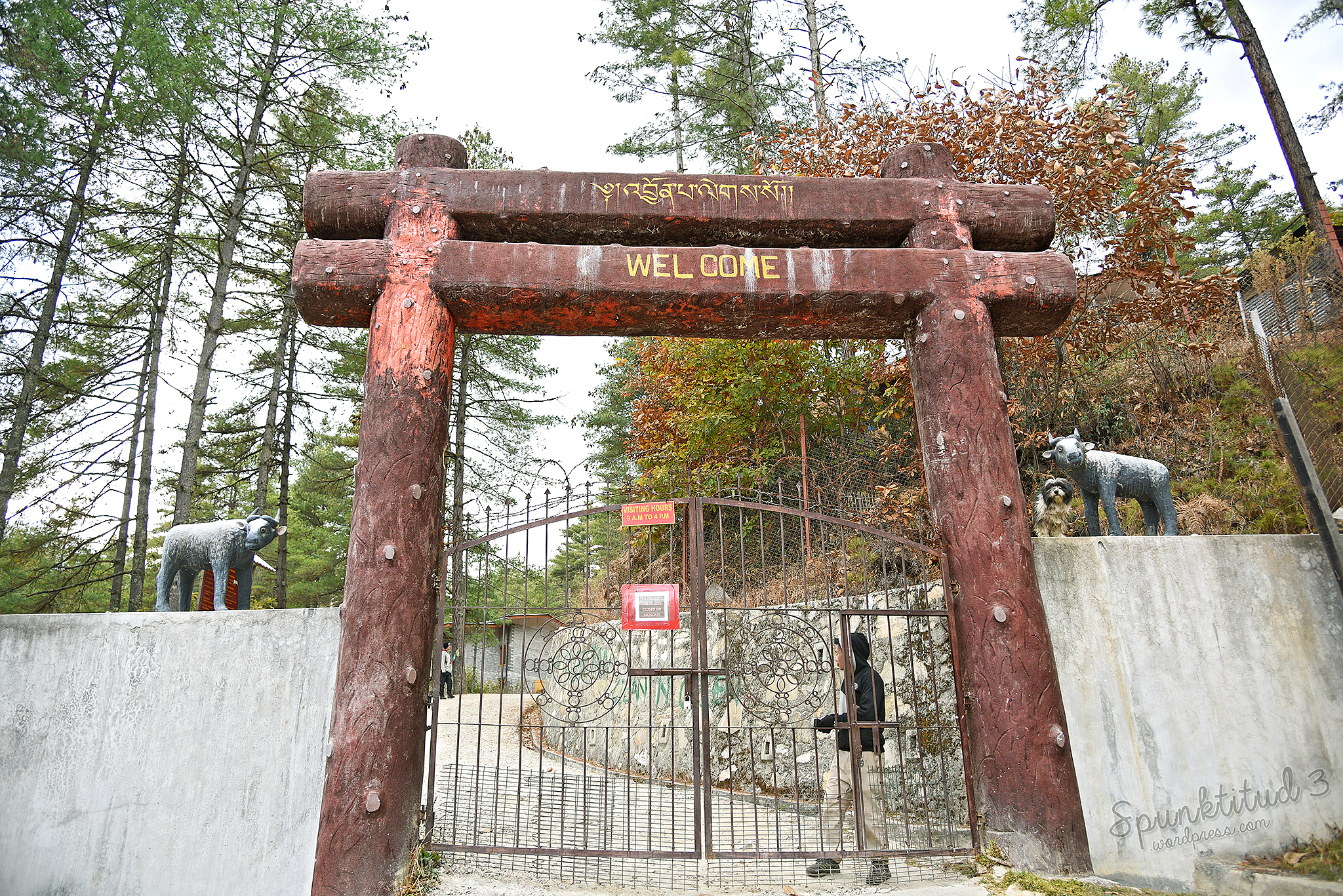 With that intense gaze, this kitty could be the feline version of Steve McCurry’s Afghan girl. In actuality, she was wary of foreign intrusion in the form of a nosy visitor (me). All rightey kitty, the alley is yours.
With that intense gaze, this kitty could be the feline version of Steve McCurry’s Afghan girl. In actuality, she was wary of foreign intrusion in the form of a nosy visitor (me). All rightey kitty, the alley is yours.
Monthly Archives: November 2016
Tsuta 蔦 – One Michelin-star Ramen in Singapore

Tsuta, the world’s first and only Michelin star ramen eatery, has opened its first overseas branch in Singapore at Pacific Plaza.
 Naturally, a queue is to be expected. At Tsuta’s original nine-seater store in Sugamo, diners queue as early as 6am for a ticket to enter the nine-seater eatery which only opens at 11am. So the 1-hour queue here doesn’t sound that bad afterall.
Naturally, a queue is to be expected. At Tsuta’s original nine-seater store in Sugamo, diners queue as early as 6am for a ticket to enter the nine-seater eatery which only opens at 11am. So the 1-hour queue here doesn’t sound that bad afterall.
 Best thing to do while you queue – look at the menu and decide what you will have. Two basic ramen choices are available – the Shoyu Soba and Shio Soba which comes with char siu, bamboo shoots, and ajitama (flavoured egg). A miso version will be introduced at a later phase.
Best thing to do while you queue – look at the menu and decide what you will have. Two basic ramen choices are available – the Shoyu Soba and Shio Soba which comes with char siu, bamboo shoots, and ajitama (flavoured egg). A miso version will be introduced at a later phase.
The shoyu ramen is made with a special soya sauce and a dashi stock of chicken, vegetables, clams and seafood, and topped with black truffle puree. The shio version is made with seafood and chicken stock together with Okinawa sea salt and Mongolian rock salt, and served with green olives in truffle oil.
 Owner-chef Yuki Onishi, who used to be in the fashion industry, learnt how to cook ramen from his father. Tsuta emphasizes on using only natural ingredients, and to ensure quality the chef uses a custom-brewed shoyu from Wakayama Prefecture from soya beans that have been aged for two years, and another one that is concocted by Onishi himself. The noodles are also made with a blend of four wholewheat flours. The chef also introduced Western influences by adding truffle puree into his recipe.
Owner-chef Yuki Onishi, who used to be in the fashion industry, learnt how to cook ramen from his father. Tsuta emphasizes on using only natural ingredients, and to ensure quality the chef uses a custom-brewed shoyu from Wakayama Prefecture from soya beans that have been aged for two years, and another one that is concocted by Onishi himself. The noodles are also made with a blend of four wholewheat flours. The chef also introduced Western influences by adding truffle puree into his recipe.
 Once seats are available, you will be lead inside to place your order at a vending machine. Simply hand over the tickets to the counter staff once you are seated.
Once seats are available, you will be lead inside to place your order at a vending machine. Simply hand over the tickets to the counter staff once you are seated.
 After an one hour wait, I am finally inside the 18-seater ramen eatery. And hungry.
After an one hour wait, I am finally inside the 18-seater ramen eatery. And hungry.
 Diners can watch as the chefs prepare your bowl of noodles.
Diners can watch as the chefs prepare your bowl of noodles.
 The delightful look of anticipation
The delightful look of anticipation
 Finally I am presented with my bowl of Ajitama Shoyu Soba! To be honest I was initially unimpressed by its appearance. My first taste of the broth fared much better. It was lighter than most ramen I have eaten before, and the truffle puree added a fragrant taste to it. I like the smooth, springy texture of the noodles and the flavoured egg. I felt that the pork char siu was a bit tough and lean for my liking (I would have preferred a bit more fat). Overall, I enjoyed my bowl of ramen, since I cleaned up the entire bowl. Being lighter in flavour, you will not get an overly-full feeling as with oilier versions. Would I queue again? Maybe, if the queue is under 30 minutes.
Finally I am presented with my bowl of Ajitama Shoyu Soba! To be honest I was initially unimpressed by its appearance. My first taste of the broth fared much better. It was lighter than most ramen I have eaten before, and the truffle puree added a fragrant taste to it. I like the smooth, springy texture of the noodles and the flavoured egg. I felt that the pork char siu was a bit tough and lean for my liking (I would have preferred a bit more fat). Overall, I enjoyed my bowl of ramen, since I cleaned up the entire bowl. Being lighter in flavour, you will not get an overly-full feeling as with oilier versions. Would I queue again? Maybe, if the queue is under 30 minutes.
Tsuta 蔦 Ramen Singapore
Address: 9 Scotts Road, #01-01, Pacific Plaza, Singapore 228210
Tel: 6734 4886
Opening Hours: 11:00AM to 10:00PM daily
Facebook page: https://www.facebook.com/Tsutasingapore
Tsuta Ramen Japan
Address: 〒170-0002, 1 Chome-14-1 Sugamo, Toshima, Tokyo 170-0002, Japan
Opening Hours: 11:00AM to 4:00PM, 6:00PM to 9:00PM daily
Phone: +81 3 3943 1007
Bhutan – Catch sight of a real-life mythical creature at Motithang Takin Preserve
 At Motithang Takin Preserve in Thimphu, you will find an interesting animal with the head of a goat and body of a cow. Its creation is linked to local mythology dating back to the 15th century.
At Motithang Takin Preserve in Thimphu, you will find an interesting animal with the head of a goat and body of a cow. Its creation is linked to local mythology dating back to the 15th century.
 The wildlife preserve is located 15 minutes drive outside of Thimphu city, and about 40 minutes by car from Paro. Motithang was originally a mini-zoo which was closed because the King of Bhutan felt it was improper for a Buddhist country to confine animals. The animals in the zoo were released, but the gentle takin which have long been domesticated, didn’t leave the area and ended up roaming the streets of Thimphu in search of food. The 8.4 acre wildlife reserve was thus set up as a place where the takin can roam safely.
The wildlife preserve is located 15 minutes drive outside of Thimphu city, and about 40 minutes by car from Paro. Motithang was originally a mini-zoo which was closed because the King of Bhutan felt it was improper for a Buddhist country to confine animals. The animals in the zoo were released, but the gentle takin which have long been domesticated, didn’t leave the area and ended up roaming the streets of Thimphu in search of food. The 8.4 acre wildlife reserve was thus set up as a place where the takin can roam safely.
 Our furry friend trying to masquerade as the mythical creature. So cute!
Our furry friend trying to masquerade as the mythical creature. So cute!
 The wildlife preserve is mostly fenced up with some openings where visitors can take photos and get a clearer look. Otherwise, the privacy of the takin is highly protected.
The wildlife preserve is mostly fenced up with some openings where visitors can take photos and get a clearer look. Otherwise, the privacy of the takin is highly protected.
 As I gazed into the far woods where the creatures were peacefully grazing, I was quite sure I would never know how they really looked like in real life.
As I gazed into the far woods where the creatures were peacefully grazing, I was quite sure I would never know how they really looked like in real life.
 So you can imagine my uber excitement when a curious takin made its way down the woods and came near us. I could feel a tingle going down my spine! What an amazing creature, I had never seen anything like it before. My Bhutanese guide proudly told me, “Because it is so special, that’s why we name it as our national animal. It is unique just like Bhutan. ”
So you can imagine my uber excitement when a curious takin made its way down the woods and came near us. I could feel a tingle going down my spine! What an amazing creature, I had never seen anything like it before. My Bhutanese guide proudly told me, “Because it is so special, that’s why we name it as our national animal. It is unique just like Bhutan. ”
Folklore has it that a Tibetan saint by the name of Drukpa Kunley, popularly known as “The Divine Madman” was requested by the Bhutanese people to conjure a miracle before them during one of his religious lectures. The saint agreed to do so provided he was given a whole cow and a whole goat for lunch. After eating both the cow and goat (what a huge appetite!), the saint put the head of the goat on the skeleton of the cow and with a snap of his fingers, the animal sprang up and came to life. The animal was then given the name dong gyem tsey (takin). Since then this animal has been a common sight in the high hills of Bhutan. Because of this magical creation with highly religious association, the animal was named as the national animal of Bhutan on 25th November 1985.
 In a more realistic context, the takin (Budorcas taxicolor whitei), also called cattle chamois or gnu goat, is listed as a vulnerable species of goat-antelope native to Bhutan, India, China and Tibet. Adult takin have a golden yellow and brownish coat while calves are black in colour.
In a more realistic context, the takin (Budorcas taxicolor whitei), also called cattle chamois or gnu goat, is listed as a vulnerable species of goat-antelope native to Bhutan, India, China and Tibet. Adult takin have a golden yellow and brownish coat while calves are black in colour.
Takin are found from forested valleys to rocky, grass-covered alpine zones, at altitudes between 1,000 and 4,500 m above sea level. They are found in small family groups of around 20 individuals, although older males may lead more solitary existences. In the summer months, herds of up to 300 gather high on the mountain slopes. Salt is also an important part of their diet, and groups may stay at a mineral deposit for several days. So you may chance upon a herd of takin licking on rocks, taking in the salt found in the rocks.
 Rather than localised scent glands, the takin has an oily, strong-smelling substance secreted over the whole body which keeps them dry. This is likely the reason for the swollen appearance of its face (I must have takin genes too). Due to this feature, biologist George Schaller likened the takin to a “bee-stung moose” although research has found it to be more related to sheep, mehhh.
Rather than localised scent glands, the takin has an oily, strong-smelling substance secreted over the whole body which keeps them dry. This is likely the reason for the swollen appearance of its face (I must have takin genes too). Due to this feature, biologist George Schaller likened the takin to a “bee-stung moose” although research has found it to be more related to sheep, mehhh.
When in danger, the takin will give an alarm call that resembles a cough and the herd will retreat into thick bamboo thickets and lie on the ground for camouflage.
The only confirmed natural predator of takin is the snow leopard, and opportunistic Asiatic black bears and gray wolves. Humans pose a greater threat to the takin, although poaching is thankfully not common.
 The preserve is also home to some sambar and barking deer. It takes only about 30mins to walk the small reserve, but it’s also the only place where you can see the takin (unless you are prepared to hike up the mountains and pray to catch sight of one). Coming face to face with the takin was a surreal experience especially when you hear of its mythical origin, so I would recommend dropping by the reserve for a visit.
The preserve is also home to some sambar and barking deer. It takes only about 30mins to walk the small reserve, but it’s also the only place where you can see the takin (unless you are prepared to hike up the mountains and pray to catch sight of one). Coming face to face with the takin was a surreal experience especially when you hear of its mythical origin, so I would recommend dropping by the reserve for a visit.
Motithang Takin Preserve
Opening Hours: 9:00AM to 4:00PM; Tue-Sun
Admission Fee: Bhutanese/SAARC national/adult Nu 10/30/50
More of my travel adventures in Bhutan
Bhutan – Buddha Dordenma: Marvel at one of the largest Buddha statues in the world
 The Buddha Dordenma is an iconic monument sitting atop a forest hill overlooking Bhutan’s capital city of Thimphu. Viewable from any part of the city, the massive statue of Shakyamuni is sited amidst Kuensel Phodrang where the palace of Sherab Wangchuck (the thirteenth Desi Druk who ruled the country from 1744 to 1763) once stood. It is one of the largest Buddha Rupas (or statues) in the world measuring at a height of 51.5 metres. Made of bronze and gilded in gold, the statue alone cost USD$47 million. Manufactured in China, the statue was cut into pieces and then transported to site through Phuentsholing (imagine the awe of wide-eyed Bhutanese villagers seeing the gigantic head of Buddha at the back of a moving lorry, priceless).
The Buddha Dordenma is an iconic monument sitting atop a forest hill overlooking Bhutan’s capital city of Thimphu. Viewable from any part of the city, the massive statue of Shakyamuni is sited amidst Kuensel Phodrang where the palace of Sherab Wangchuck (the thirteenth Desi Druk who ruled the country from 1744 to 1763) once stood. It is one of the largest Buddha Rupas (or statues) in the world measuring at a height of 51.5 metres. Made of bronze and gilded in gold, the statue alone cost USD$47 million. Manufactured in China, the statue was cut into pieces and then transported to site through Phuentsholing (imagine the awe of wide-eyed Bhutanese villagers seeing the gigantic head of Buddha at the back of a moving lorry, priceless).
This is part of a greater whole, which includes the Kuensel Phodrang Nature Park, a 943-acre nature park inaugurated in 2011 to preserve the forests surrounding the statue. The entire project, which took about 10 years to complete on 25 September 2015, cost over USD$100 million. Locals and tourists alike embrace the park, which is popular for weekend family outings and its biking, hiking and nature trails. The park also hosted the Peling Tsechu, a three-day festival held in May 2016 to commemorate the birth of His Royal Highness Gyalsey Jigme Namgyel Wangchuck. The three-storey base houses a large chapel, while the body itself is filled with 125,000 gold statues of Buddha. The statue is expected to be a major pilgrimage centre and a focal point for Buddhists all over the world to converge, practice, meditate, and retreat.
The three-storey base houses a large chapel, while the body itself is filled with 125,000 gold statues of Buddha. The statue is expected to be a major pilgrimage centre and a focal point for Buddhists all over the world to converge, practice, meditate, and retreat. Apart from commemorating the 60th birth anniversary of Bhutan’s fourth king Jigme Singye Wangchuck, it fulfills two prophecies. In the twentieth century, the renowned yogi Sonam Zangpo prophesied that a large statue of either Padmasambhava, Buddha or of a phurba would be built in the region to bestow blessings, peace and happiness to the entire world. The statue itself is mentioned in an ancient terma of Guru Padmasambhava himself, said to date from approximately the 8th century, and recovered some 800 years ago by Terton Pema Lingpa (Religious Treasure Discoverer).
Apart from commemorating the 60th birth anniversary of Bhutan’s fourth king Jigme Singye Wangchuck, it fulfills two prophecies. In the twentieth century, the renowned yogi Sonam Zangpo prophesied that a large statue of either Padmasambhava, Buddha or of a phurba would be built in the region to bestow blessings, peace and happiness to the entire world. The statue itself is mentioned in an ancient terma of Guru Padmasambhava himself, said to date from approximately the 8th century, and recovered some 800 years ago by Terton Pema Lingpa (Religious Treasure Discoverer). For me, I am just happy to be blessed with such an amazing view.
For me, I am just happy to be blessed with such an amazing view. The Buddha Dordenma overlooks the Southern entrance to Thimphu Valley, and visitors can enjoy a vantage view of Thimphu nestled in the valley below.
The Buddha Dordenma overlooks the Southern entrance to Thimphu Valley, and visitors can enjoy a vantage view of Thimphu nestled in the valley below. Thimphu being the capital city is the most developed and densely populated area in Bhutan, so this sight of closely-packed buildings is not the norm in other parts of the country which are mostly mountains, forests and farmlands. With urbanization, Bhutanese youths are increasingly migrating to Thimphu in search of white-collar jobs and a better life. I wonder how many dreams these buildings hold?
Thimphu being the capital city is the most developed and densely populated area in Bhutan, so this sight of closely-packed buildings is not the norm in other parts of the country which are mostly mountains, forests and farmlands. With urbanization, Bhutanese youths are increasingly migrating to Thimphu in search of white-collar jobs and a better life. I wonder how many dreams these buildings hold?
 One thing I know for sure, Bhutan is not ready to give up their unique cultural identity for modernization, and the little kingdom is gingerly treading the waters of urbanization, step by step, without compromising on the values which they have held closely for centuries. If there is a country left in the world who can find a delicate balance between culture and economic progress, it would be Bhutan.
One thing I know for sure, Bhutan is not ready to give up their unique cultural identity for modernization, and the little kingdom is gingerly treading the waters of urbanization, step by step, without compromising on the values which they have held closely for centuries. If there is a country left in the world who can find a delicate balance between culture and economic progress, it would be Bhutan.
Buddha Dordenma
Opening Hours: 9:00AM to 5:00PM daily
Website: www.buddhadordenma.org
More of my travel adventures in Bhutan
